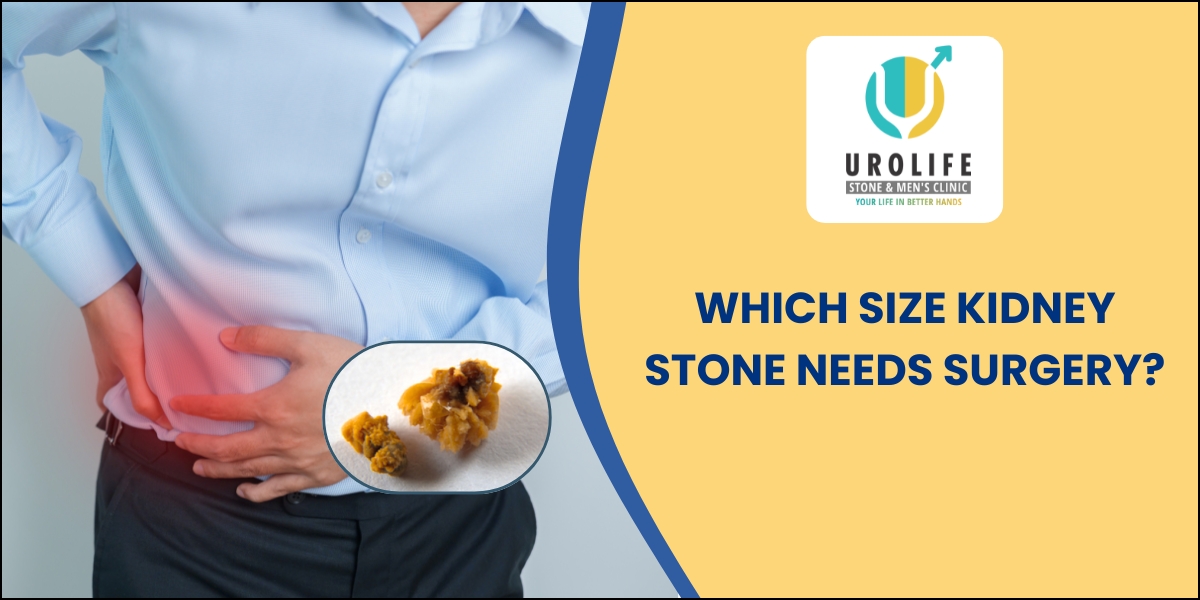If you’ve ever experienced the searing pain of a kidney stone, you know it’s an ordeal you never want to repeat. Often described as worse than childbirth, this pain leaves one urgent question in its wake: “Will I need surgery?” The answer, more often than not, depends on one critical factor: the size of the stone.
While small stones often pass on their own, larger ones can become lodged, causing unbearable pain, infections, or even kidney damage. Understanding the thresholds for surgical intervention can empower you to make informed decisions about your health. Let’s break down the numbers and the medical reasoning behind them.
The Golden Rule: The 5mm Threshold
In urology, the 5-millimeter (mm) mark is a crucial dividing line. Think of it as the size of a pencil eraser or a small pea.
-
Stones smaller than 5mm: These have a high chance of passing naturally. Approximately 90% of stones under 5mm will pass through the urinary tract with conservative management. This typically involves:
-
Hydration: Drinking 2-3 liters of water daily to help flush the stone out.
-
Pain Management: Using prescribed pain relievers and anti-inflammatory medications to manage discomfort.
-
Medication: Alpha-blockers like Tamsulosin can relax the ureter muscles, making passage easier and less painful.
-
Light Activity: Gentle movement can sometimes encourage the stone to move along.
-
-
Stones larger than 5mm: The likelihood of spontaneous passage drops significantly. As stones approach and exceed 10mm (1 cm), the chance of passing without intervention is less than 20%. These larger stones are prime candidates for surgery.
When Surgery Becomes Necessary: Beyond Just Size
While size is the primary indicator, it’s not the only factor urologists consider. Surgery may be recommended for a smaller stone, or sometimes delayed for a slightly larger one, based on these accompanying conditions:
-
Location and Obstruction: A 4mm stone lodged in the ureter (the tube connecting the kidney to the bladder) causing a complete blockage is more dangerous than a 7mm stone sitting quietly in the kidney. Obstruction can lead to hydronephrosis (swelling of the kidney), which, if left untreated, can cause permanent kidney damage.
-
Intractable Pain: If the pain is severe and cannot be controlled with standard oral medications, impacting your ability to eat, sleep, or function, surgery becomes a necessary option for relief.
-
Infection: The combination of an obstructing stone and a urinary tract infection is a urological emergency. This can lead to pyonephrosis (pus in the kidney) or sepsis, a life-threatening condition. Surgery is required urgently to drain the infection and remove the stone.
-
Impaired Kidney Function: If tests show that the stone is affecting how your kidney is working, intervention is needed to preserve long-term kidney health.
-
Recurrent Stones or Large Stone Burden: If you have multiple stones or one very large stone (a staghorn calculus that fills the kidney’s collecting system), even if not immediately painful, surgery is often advised to prevent future complications and infections.
-
Occupational or Social Reasons: For individuals whose jobs require them to be always alert (like pilots, bus drivers, or machine operators), waiting for a stone to pass is not a safe option. Proactive removal is recommended.
Modern Surgical Options: Less Invasive, Highly Effective
Gone are the days of large, invasive surgeries for kidney stones. Today’s procedures are minimally invasive, focusing on precision and faster recovery.
-
Shock Wave Lithotripsy (SWL): Ideal for stones between 5mm and 10mm located in the kidney or upper ureter. This non-invasive procedure uses sound waves to break the stone into tiny fragments that can be passed in the urine.
-
Ureteroscopy (URS): The gold standard for stones in the ureter or kidney that are between 10mm and 20mm. A thin, flexible scope is passed through the natural urinary pathway to locate the stone. A laser is then used to break it into dust or fragments, which are removed. No incisions are made.
-
Percutaneous Nephrolithotomy (PCNL): Reserved for large, complex stones over 20mm (2 cm) or staghorn calculi. A small incision (about 1 cm) is made in the back to create a direct tunnel to the kidney. A nephroscope is used to locate and remove the stones. It is the most invasive of the modern options but is incredibly effective for massive stones.
Consult a Kidney Stone Specialist – Dr. Irfan Shaikh
If you have been diagnosed with a kidney stone, the most important step is to consult a urologist. They will consider the stone’s size, location, your anatomy, and your symptoms to create a personalized treatment plan. A “wait and see” approach can be safe for small stones, but knowing when to intervene is key to preventing serious complications.
Remember, timely and expert care ensures the best outcome, preserving your kidney function and getting you back to a pain-free life.
Struggling with Kidney Stones in Pune? Consult the Expert.
If you or a loved one is seeking answers for kidney stone treatment, navigating the options alone can be overwhelming. The decision between medical management and surgery requires expert evaluation and advanced technology.
For residents of Pune and beyond, Dr. Irfan Shaikh at Urolife Clinic is a trusted name in urological care. Renowned as one of the best kidney stone specialists in Pune.
At Urolife Clinic Pune, every patient receives a comprehensive diagnosis and a tailored treatment plan. Whether your stone requires vigilant monitoring, medication, or a minimally invasive procedure like Laser Ureteroscopy or PCNL, you are in capable hands. Dr. Shaikh and his team are dedicated to providing the most effective, least invasive solution to ensure a quick recovery and long-term kidney health.
Don’t let kidney stone pain control your life. Schedule a consultation with Dr. Irfan Shaikh – your best choice for kidney stone treatment in Pune – and take the first step towards a stone-free future.
